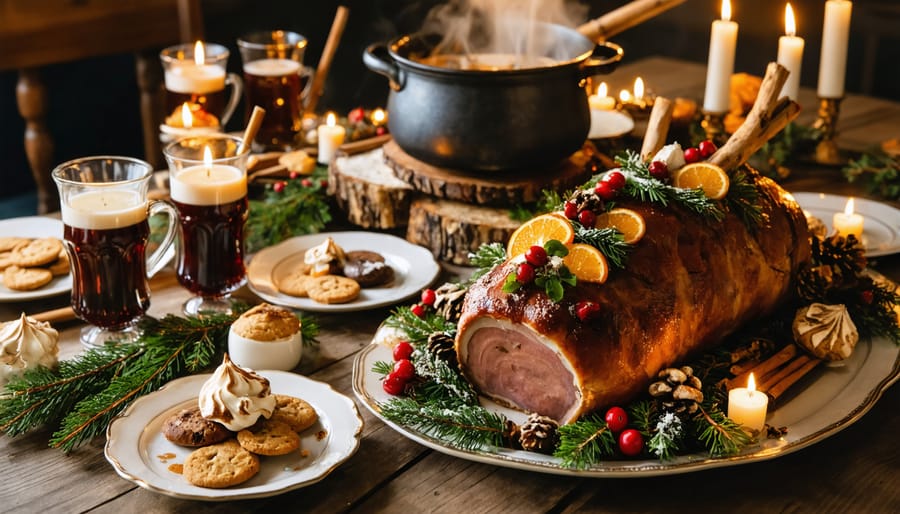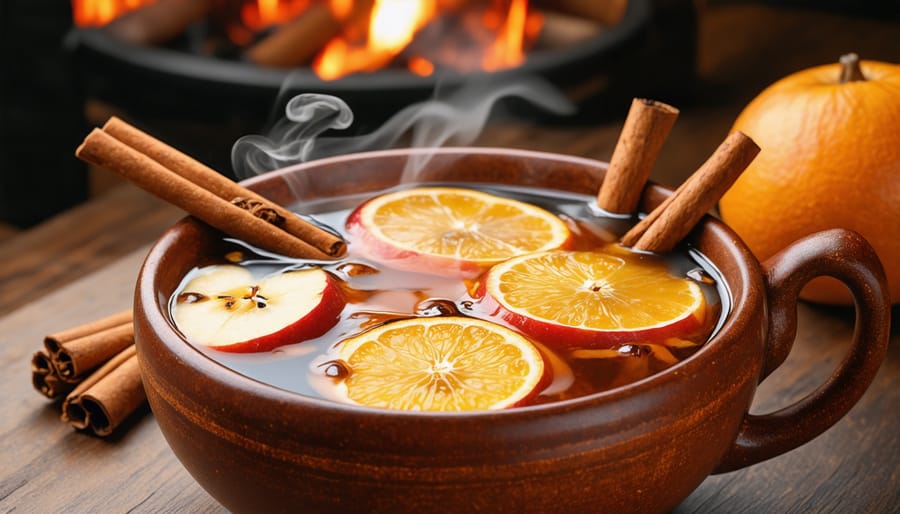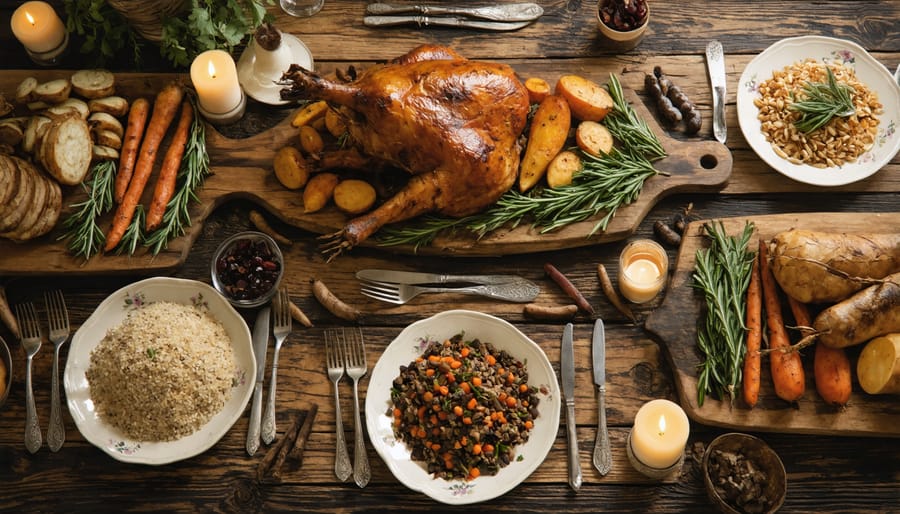
Step into the warmth of ancient winter celebrations with recipes that have graced holiday tables for generations. As families embrace modern Yule traditions, these time-honored dishes carry whispers of medieval feasts and Victorian celebrations into our contemporary kitchens.
From the rich, spiced aromas of wassail brewing on the stovetop to the gentle sweetness of traditional honey cakes, Yule recipes tell stories of abundance, community, and sacred celebration. Each dish serves as a delicious connection to our ancestors, who gathered around flickering hearths during the longest nights of winter to share food, stories, and hope for the returning sun.
Whether you’re drawn to the hearty comfort of roasted wild game with rosemary and juniper, or the simple joy of baking star-shaped cookies dusted with winter spices, these recipes offer more than just nourishment – they’re a tangible way to weave ancient wisdom and festive magic into your holiday celebrations. Let’s explore these cherished recipes that have sustained both body and spirit through countless winter solstices.
The Heart of Yule: Traditional Wassail and Mulled Drinks
Classic Wassail Recipe
Nothing warms my heart quite like brewing up a batch of traditional wassail during the winter months. This centuries-old holiday drink has been bringing communities together since medieval times, when revelers would go “wassailing” – singing door-to-door and sharing this warming spiced cider with neighbors.
To make your own wassail, you’ll need:
– 6 cups apple cider
– 2 cups orange juice
– 1/2 cup lemon juice
– 4 cinnamon sticks
– 12 whole cloves
– 2 star anise pods
– 1 inch fresh ginger, sliced
– 1 orange, sliced
– 1 apple, sliced
– Optional: 1 cup brandy or dark rum
In a large pot, combine the apple cider, orange juice, and lemon juice. Add your spices, ginger, and fruit slices. Bring the mixture to a gentle simmer over medium heat, then reduce to low and let it steep for at least 30 minutes. The longer it simmers, the more the flavors will develop. For adult gatherings, you can add brandy or rum just before serving.
I love serving wassail in heavy mugs garnished with orange slices and cinnamon sticks. The aroma alone transforms any gathering into a festive occasion, and there’s something magical about sharing this traditional drink that has brought joy to holiday celebrations for generations.
Remember to strain the spices before serving, though I usually leave some fruit slices in the mugs for both decoration and flavor. This recipe serves 8-10 people and can be kept warm in a slow cooker for parties.

Spiced Mead and Mulled Wine
There’s something magical about gathering around a steaming pot of spiced mead or mulled wine during the winter solstice. As someone who’s spent countless holiday evenings perfecting these warming holiday beverages, I can tell you that the secret lies in finding the perfect balance of spices.
For a traditional spiced mead, start with a good-quality honey wine and warm it gently – never let it boil! Add three cinnamon sticks, five whole cloves, two star anise pods, and a few strips of orange peel. My grandmother taught me to add a tiny pinch of black pepper, which might sound strange but truly brings all the flavors together.
Creating mulled wine is similarly straightforward, though the tradition dates back to medieval times when spices were considered precious commodities. Choose a full-bodied red wine (I prefer Merlot or Cabernet), and warm it with cinnamon, cloves, and orange slices. Add honey to taste – about 2-3 tablespoons usually does the trick. For a modern twist, I love throwing in a few cranberries and a splash of brandy.
Remember to let the spices steep for at least 20 minutes before serving, but don’t leave them too long as they can become bitter. Serve these drinks in heat-safe mugs, perhaps garnished with a cinnamon stick or orange slice. They’re perfect for sharing stories around the fire as we celebrate the longest night of the year.
Hearth and Home: Yule Log Cake and Sweet Treats

Traditional Yule Log Cake (Bûche de Noël)
The Bûche de Noël has always been one of those treasured family recipes that brings pure magic to the holiday table. As someone who once feared rolling cakes, I can assure you that this festive masterpiece is more achievable than you might think!
Start with a light chocolate sponge cake made with 4 eggs, 100g sugar, 65g flour, and 35g cocoa powder. The key is whipping your eggs and sugar until they’re pale and fluffy – this creates that perfect, rollable texture. Spread the batter evenly on a lined baking sheet and bake at 350°F (175°C) for just 10-12 minutes.
While it’s still warm, roll the cake in a clean tea towel dusted with cocoa powder. This prevents cracking when you fill it later. Let it cool completely while you prepare the filling: whip 2 cups of heavy cream with 1/4 cup powdered sugar and a splash of vanilla until stiff peaks form.
Here’s where the fun begins! Unroll your cake (don’t worry if it cracks a little), spread the whipped cream filling, and re-roll it snugly. Slice off one end at an angle and position it on the side of your log to create a branch effect.
For the classic bark-like appearance, cover the entire cake with chocolate buttercream (1 cup butter, 3 cups powdered sugar, 1/2 cup cocoa powder, and vanilla). Use a fork to create wood grain patterns, then dust with powdered sugar “snow.” For extra woodland charm, add meringue mushrooms, sugared cranberries, or tiny rosemary sprigs.
Remember, perfection isn’t the goal – real logs have character! Each little crack and swirl adds to its rustic charm, making your Bûche de Noël uniquely yours. Store it in the refrigerator until about 30 minutes before serving, when those lovely flavors and textures are at their best.
Honey and Spice Cookies
There’s something magical about the aroma of spiced cookies wafting through your home during the winter months. These honey and spice cookies, a cherished Yule tradition dating back centuries, combine the sweetness of golden honey with warming winter spices that our ancestors believed held protective properties during the darkest days of the year.
I remember learning this recipe from my grandmother, who always said the secret was in letting the dough rest overnight, allowing the spices to fully bloom. The traditional blend typically includes cinnamon, ginger, nutmeg, and cloves – spices that were once considered precious gifts during the winter solstice celebrations.
Today’s version stays true to its ancient roots while offering modern conveniences. You can use regular all-purpose flour instead of the historical blend of rye and wheat, and electric mixers make the dough preparation much easier than the arm-working process of old. For a contemporary twist, try adding orange zest or a dash of cardamom – both complement the traditional spice blend beautifully.
The cookies should be firm but not hard, with a subtle chew and a glossy finish from the honey glaze. They’re perfect for gifting, especially when packaged in rustic brown paper tied with twine – a thoughtful nod to the simplicity of traditional Yule celebrations. Make extra batches; trust me, they disappear quickly during holiday gatherings!

Festive Main Dishes and Sides
Roasted Wild Game with Herbs
The heart of any traditional Yule feast lies in its centerpiece – a beautifully roasted wild game dish that fills the home with irresistible aromas. In medieval times, families would hunt deer, boar, or rabbit specifically for this special occasion. Today, we can recreate these classic flavors while adapting to modern availability and preferences.
For those who can source it, venison makes an exceptional choice, embodying the wild spirit of ancient Yuletide celebrations. I love preparing it with a blend of winter herbs – rosemary, thyme, and juniper berries – that not only enhance the meat’s natural flavors but also carry traditional significance as symbols of protection and renewal.
Don’t worry if wild game isn’t readily available in your area. You can capture the essence of this dish using grass-fed beef, lamb, or even a hearty mushroom roast for vegetarian guests. The key lies in the aromatic herb coating and slow-roasting method that our ancestors used.
My favorite preparation method involves creating a paste with fresh herbs, garlic, and a touch of honey (a nod to ancient Norse traditions). After rubbing this mixture generously over your chosen meat, let it rest for several hours to absorb the flavors. Roast slowly at a low temperature until perfectly done – the meat should be tender enough to pull apart with a fork.
Remember, the goal isn’t just to recreate a recipe but to connect with the spirit of celebration that has brought families together around the Yule table for generations.
Root Vegetable Medley
When I think of Yule celebrations, the aroma of roasted root vegetables always takes me back to my grandmother’s kitchen. This hearty medley of winter vegetables isn’t just delicious – it’s a celebration of the earth’s bounty during the coldest months. As part of our traditional seasonal vegetable dishes, this colorful combination of parsnips, carrots, turnips, and sweet potatoes brings both nutrition and symbolic meaning to the Yule table.
Start by choosing firm, fresh vegetables – I particularly love using heritage varieties when I can find them at the farmer’s market. Peel and cut them into similar-sized chunks (about 1-inch pieces work perfectly), then toss them with olive oil, fresh rosemary, thyme, and a generous pinch of sea salt. The magic happens when you roast them at 400°F (200°C) for about 40 minutes, stirring halfway through.
What makes this dish truly special is the honey-herb glaze added in the final 10 minutes of cooking. Simply drizzle two tablespoons of local honey mixed with a splash of apple cider vinegar over the vegetables, letting them caramelize to perfection. The sweetness of the honey represents the returning sun at Yule, while the earthy herbs connect us to the sleeping winter earth.
This medley serves beautifully alongside any main dish, and leftovers (if you’re lucky enough to have any!) taste even better the next day. Remember to save the peels for your compost – it’s a wonderful way to honor the cycle of the seasons.
Ancient Grain Side Dishes
Ancient grains have been a cornerstone of Yule celebrations for centuries, offering both sustenance and symbolic meaning during the darkest days of winter. One of my favorite traditional side dishes is Barley Blessing Bowl, a hearty mixture of pearl barley, dried fruits, and nuts that represents abundance for the coming year. When I make this dish, I love how the kitchen fills with the warm, nutty aroma that reminds me of holidays past.
Spelt Berry Pilaf, another time-honored dish, combines this ancient wheat variety with caramelized onions and winter herbs. The slight chewiness of spelt berries provides a delightful texture that pairs beautifully with roasted meats. For added authenticity, try cooking it in bone broth rather than water – a technique our ancestors would have used to maximize nutrition during winter months.
Don’t overlook the humble Yule Oat Cakes, thin, crispy rounds traditionally served as an offering during solstice celebrations. These simple yet satisfying cakes are made with stone-ground oats, butter, and a pinch of salt. I’ve found that adding a touch of honey makes them more appealing to modern palates while maintaining their historical integrity.
For those seeking something truly special, the Freya’s Feast Grain Medley combines three ancient grains – quinoa, amaranth, and millet – with roasted root vegetables and winter herbs. This colorful dish not only honors Norse traditions but also provides a nutrient-rich addition to your holiday table.
As we wrap up our journey through these cherished Yule recipes, I’m reminded of how food connects us not just to our present celebrations, but to countless generations before us. Every time I prepare my grandmother’s spiced cider or roll out the dough for traditional Yule log cake, I feel that magical thread of connection stretching back through time.
But here’s the beautiful thing about traditions – they’re meant to evolve while keeping their heart intact. You don’t need to source rare medieval spices or spend three days in the kitchen to honor these ancient customs. Maybe your Wassail bowl is made in a slow cooker instead of over an open fire, or perhaps you’ve adapted that traditional pudding recipe to accommodate modern dietary preferences. That’s not just okay – it’s exactly how traditions stay alive and relevant.
The key is understanding the intention behind these dishes. Our ancestors celebrated the return of longer days with rich, warming foods that brought people together. They created special treats that marked this time as sacred and extraordinary. When we prepare these recipes – whether following them to the letter or adding our own modern twist – we’re participating in that same beautiful tradition of nurturing our loved ones and marking the season’s change.
I encourage you to start small. Choose one or two recipes that speak to you and make them part of your family’s celebration. Share them with friends, tell the stories behind them, and don’t be afraid to adapt them to suit your needs. Take photos, write down your variations, and create your own family cookbook. These moments in the kitchen, these shared meals and celebrations, are how we create our own links in the chain of tradition.
Remember, the most important ingredient in any of these recipes isn’t found in your pantry – it’s the intention and love you put into preparing them. Here’s to keeping these beautiful Yule traditions alive, one delicious dish at a time.



